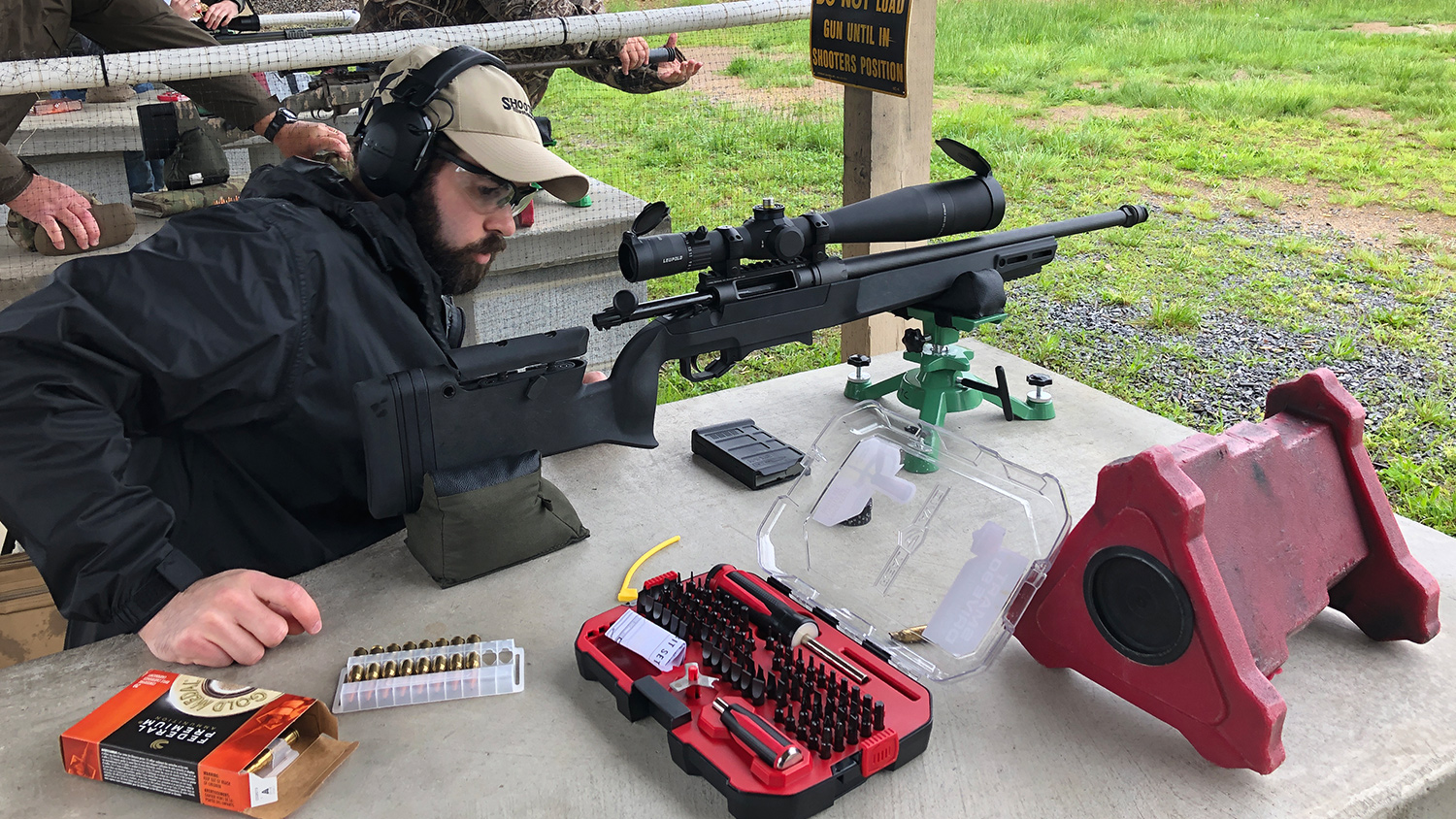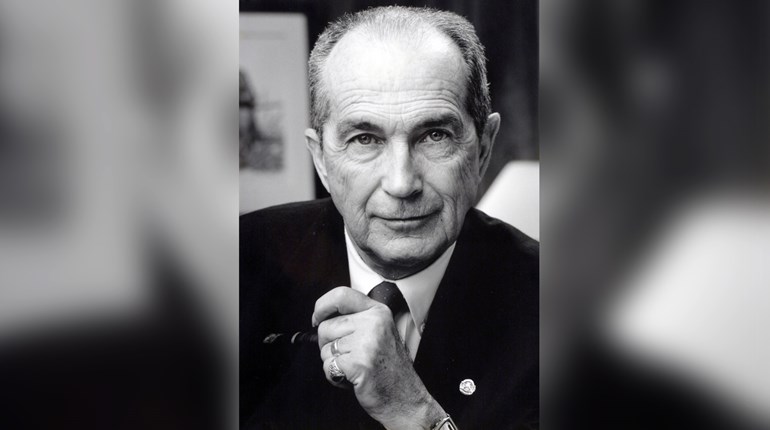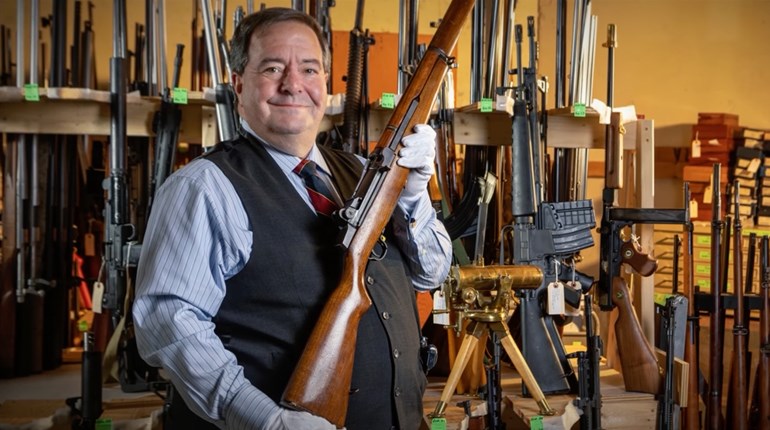
Learning the difference between accuracy and precision, along with everything in-between, can sound daunting when you are just starting out in long-range shooting. As such, you need top-notch instruction. Enter the NRA’s new Long-Range Schools, conducted by NRA Competitive Shooting staff. These one-day courses are designed for entry- to intermediate-level students using their own firearm.
Available in two flavors, Beginner and Advanced, these schools are currently being held at Peacemaker National Training Center in Glengary, WV. Given the success the program has enjoyed this year thus far, there are plans to expand the classes nationwide in the future.

Recently, I attended the NRA Advanced Long-Range School, along with my usual partner in crime when venturing to Peacemaker, Shooting Illustrated’s very own Evan Brune. First lesson: long-range rifle is more fun with a friend.
On a *very* rainy Sunday in May, we learned more about the nuances of long-range shooting from a team of experts then we could have ever expected to on our own. (Read Evan’s account of the school here.)
Rifles
For this outing, I used the Devil Dog Arms Hog XLR chassis rifle in 6.5 Creedmoor (read my range review of this rifle). Topping the rifle was the Zeiss Conquest V4 6-24x50mm with MOA reticle. Usually I prefer a MIL-based scope, but I had been itching to try out the new Devil Dog after eyeballing it on the rack in Peacemaker’s pro shop, and this one already had the Zeiss on it and most importantly—it was already zeroed and ready to go.

Brune was shooting the Daniel Defense Delta 5 in .308 Win., which proved to be eye-opening for him (read his review). As for an optic, he chose the Leupold Mark 5HD 5-25x56mm with MOA reticle. You can see our full gear lists at the bottom of this article.
The 100-Yard Zero
Once you have your entire long-range rifle system figured out (rifle, optics, ammo), the next critical step for successful long-range shooting is knowing why you are missing. The “why” is critical. If you have problems nailing center at 100 yards, the problem will be amplified as you move further in distance. Therefore, sitting at the bench until you are printing tiny groups at 100 yards is a must-do.

Think about it, if you can’t do it at 100 yards, how is that going to translate at 1000 yards? It could even be dangerous to not have a good zero at 100 yards. Be smart, and learn to shoot your rifle to its maximum potential on the bench, and you will thank yourself later.
Why Your Optic Matters
Plain and simple, if you want to succeed in any type of precision rifle competition, you have to know how to adjust “inside the glass,” meaning you need an optic and reticle combination that allows you to compensate based on impacts seen through the scope. Say you are shooting a PRS stage with the clock ticking, you don’t have the time to look at a spotting scope to see your impact. It isn’t likely either, that a paper target is going to be there with a nice clean bullet hole for you to observe, instead it will be some sort of metal plate. It pays to have good glass—you are much better off with a scope you can clearly spot impacts with, so you can make your adjustments. This doesn’t necessarily mean that a more expensive optic is better, rather one that YOU are comfortable with, and allows you to properly compensate for your misses, is best.
External Ballistics
Here is where the class really delved into the “advanced” portion of instruction, after covering how to set up a proper long-range rig and sound marksmanship principals. The impact of environmental factors on the bullet, from muzzle to target, can fill an entire book. Our instructors shared examples gleaned from a collective lifetime of experience, which is the kind of instruction you can’t find by reading articles or perusing forum posts online, or watching a video on YouTube.

Long-range shooters *must* understand two key environmental factors if they want to connect like a pro: drop compensation and wind compensation. The advanced class goes in-depth on these two topics. Also covered are broad concepts like air density, altitude, angle, temperature, hit probability, multiple wind speeds and more. Additionally, classroom instruction zeroed in on easy-to-learn but hard-to-master techniques such as reading mirage through your scope, and how to handle advanced shot angle scenarios.
Bottom Line
The above is just a small sampling of what you are in for when attending an NRA Long-Range School. At only $350 for the one-day class, this advanced school represents one of the best bargains available for intermediate long-range shooters looking for quality instruction. It isn’t just the money, it is also the time factor that makes this class unique. The amount of information stuffed into the eight hours of class time is just right, not too much classroom—but enough so that you will feel well-informed before hitting the range for the second portion of the class. You will leave the school with the confidence to advance in long-range rifle shooting. Instruction on the proper use of the Kestrel weather meter to “true” your rifle is a logical next step.
There is an upcoming NRA Long-Range School on Saturday, October 5 at Peacemaker. Learn more about the class here.
Parker’s Gear—6.5 Creedmoor
- Devil Dog Arms Hog 6.5 Creedmoor Carbon XLR Chassis. $4,995, DevilDogArms.com.
- Zeiss Conquest V4 6-24x50mm ZMOA-1. $1,099.99, Zeiss.com.
- Hornady 6.5 Creedmoor 140-grain ELD Match. $29.99 per 20-round box, Hornady.com.
- Seekins 30mm Scope Rings. $129, SeekinsPrecision.com.
- Magpul Pic Rail Bipod. $109.95, Magpul.com.
- Armageddon Gamechanger bag. $109, ArmageddonGear.com.
Brune’s Gear―.308 Win.
- Daniel Defense Delta 5 .308 Win. $2,199, DanielDefense.com.
- Leupold Mark 5HD 5-25x56mm MOA. $2,599, Leupold.com.
- Federal Gold Medal Match .308 Win. 175-grain MatchKing. $33.95 per 20-round box, FederalPremium.com.
- Leupold Mark 4 35mm Scope Rings. $249.99, Leupold.com.
- Warne Skyline Bipod. $379.99, WarneScopeMounts.com.
- Phoenix “Tony Bag of Donuts” Shooting Bag. $54, PhoenixShootingBags.com.
Extras
- Zeiss Victory RF Binoculars 10x54. $3,599.99, Zeiss.com.
- Swarovski ATS 65 Spotting Scope. $2,520, SwarovskiOptik.com.
- Real Avid Smart Drive 90 Bit Set. $99.99, RealAvid.com.
- Propper Expandable Backpack. $99.99, Propper.com.


































